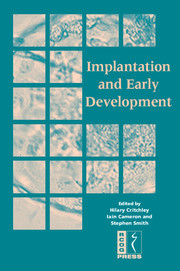Book contents
- Frontmatter
- Contents
- DECLARATION OF INTEREST
- Participants
- Preface
- SECTION 1 PREPARATION FOR IMPLANTATION – THE UTERINE ENVIRONMENT
- SECTION 2 THE EMBRYO
- 9 What makes a good egg?
- 10 What makes ‘good sperm’?
- 11 Morphogenesis of the early mammalian embryo: cell lineage heterogeneity and developmental potential
- 12 Epigenetics in development and cloning by nuclear transfer: alternative approaches to nuclear reprogramming
- 13 Risks associated with assisted reproduction: insights from animal studies
- 14 Pre-implantation genetic testing
- SECTION 3 LESSONS FROM ANIMAL MODELS (TRANSGENICS) AND NOVEL TECHNOLOGIES
- SECTION 4 CLINICAL SEQUELAE
- SECTION 5 CONSENSUS VIEWS
- Index
13 - Risks associated with assisted reproduction: insights from animal studies
from SECTION 2 - THE EMBRYO
Published online by Cambridge University Press: 05 June 2014
- Frontmatter
- Contents
- DECLARATION OF INTEREST
- Participants
- Preface
- SECTION 1 PREPARATION FOR IMPLANTATION – THE UTERINE ENVIRONMENT
- SECTION 2 THE EMBRYO
- 9 What makes a good egg?
- 10 What makes ‘good sperm’?
- 11 Morphogenesis of the early mammalian embryo: cell lineage heterogeneity and developmental potential
- 12 Epigenetics in development and cloning by nuclear transfer: alternative approaches to nuclear reprogramming
- 13 Risks associated with assisted reproduction: insights from animal studies
- 14 Pre-implantation genetic testing
- SECTION 3 LESSONS FROM ANIMAL MODELS (TRANSGENICS) AND NOVEL TECHNOLOGIES
- SECTION 4 CLINICAL SEQUELAE
- SECTION 5 CONSENSUS VIEWS
- Index
Summary
Introduction
The rapid evolution of assisted reproductive technologies (ART) over the past 30 years has completely revolutionised infertility treatment in humans, becoming a common and accepted form of clinical care benefiting an estimated one in ten people of reproductive age in developed countries who are subfertile or infertile. The success of these technologies can be credited as much to the remarkable plasticity and tolerance of mammalian gametes and the pre-implantation embryo to physical manipulations and alterations to their chemical environment as to any specific refinement that may have been introduced over the years as our understanding of early mammalian biology has evolved. This is perhaps best exemplified by the extraordinary early success enjoyed with the culture of human zygotes in simple balanced salt solutions or complex media formulated with somatic cell culture in mind. However, the empiricism with which refinements to these culture media subsequently arose together with the rather indiscriminate way in which procedures such as intracytoplasmic sperm injection (ICSI) were introduced and then adopted has led many commentators to question the safety of ART.
These concerns were heightened a number of years ago when it emerged that the extended culture of animal zygotes (particularly ruminant zygotes) could lead to a high incidence of developmental abnormalities and congenital defects in offspring which are often associated with in utero overgrowth.
Keywords
- Type
- Chapter
- Information
- Implantation and Early Development , pp. 155 - 168Publisher: Cambridge University PressPrint publication year: 2005



